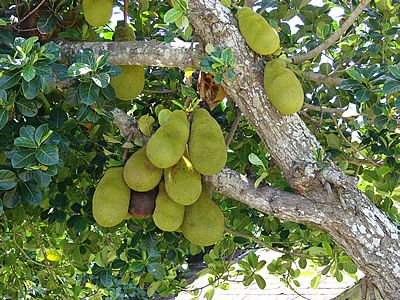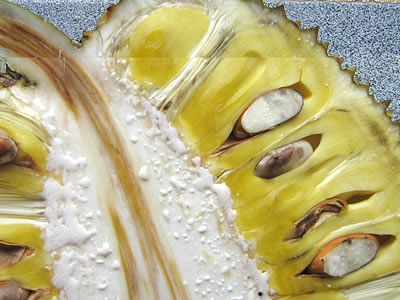The jackfruit (Artocarpus heterophyllus) is a cauliflorous and monoecious fruit tree native to India but widely distributed across various tropical regions of the planet. It is a large tree, easily reaching 30 meters (about 98 feet) in height. Its crown is pyramidal to rounded, dense, with strong, robust branches and milky sap. The leaves are typically simple, lobed only in young plants. They can be oval, oblong, or elliptical, and are entire, glossy, short-petioled, with well-marked veins and a leathery texture.
The male and female flowers appear in separate inflorescences, directly from the stem, and have little ornamental importance. The fruit is of the syncarp type, formed by the union of several carpels. It is round and somewhat elongated, with a skin covered in bumps and is quite bulky and heavy, potentially weighing up to 40 kilograms (about 88 pounds).

From flowering, it takes 3 to 8 months to reach full maturity, evident from the color change from light green to a yellow-brownish hue. The fruit yields to finger pressure and produces a tympanic sound when lightly tapped. Once ripe, it deteriorates quickly. This factor hampers transportation, storage, and conservation of jackfruits in distribution and commercialization centers, making the fruit expensive and somewhat difficult to find in non-producing areas.
There are two main varieties of jackfruit. The soft jackfruit, with smaller fruits, small carpels, sweet, soft, delicate pulp ideal for consuming fresh (in natura); and the hard jackfruit, with large fruits, firm flesh, not as sweet, almost crunchy, but equally delicious. There is also the butter jackfruit, which has an intermediate consistency and is also sweet.
In landscaping, the jackfruit tree stands out both as an imposing tree and for its curious fruits that sprout directly from the trunk. However, it is important to plan its use within the field of view but away from walkways, paths, houses, access areas, and car parking, as the fall of heavy fruits can cause serious accidents and significant material losses.
The jackfruit tree requires only cleaning pruning, keeping the inside of the plant free of weak, dead, or diseased branches, thus ensuring good illumination of the crown. Due to its beautiful foliage, young plants can be planted in pots and grown in patios, terraces, and moved indoors during the cold season. However, over time, there is a need to plant it directly in the ground for full development.

It is an interesting species to have in the home orchard, as its tasty and fragrant fruits can be consumed in many different ways. The still green fruit serves as a vegetable and can be used in various stews. It is especially interesting as a substitute for chicken or pork in vegetarian diets, as it resembles both in flavor and texture, allowing for a myriad of preparations.
Ripe jackfruit is consumed naturally, or in the form of liqueurs, jellies, etc. It is said that its flavor is tropical and its aroma, noticeable from a distance, resembles pineapple, apple, mango, and banana. The pulp is fibrous, sticky, and rich in starch, vitamins, and minerals. Even the seeds, after being cooked or roasted, are edible, tasting somewhat like chestnuts.
The wood of the jackfruit tree is of good quality and resistant to termites, being used in the manufacture of furniture, musical instruments, and boats, especially in Asia, where its use is quite traditional.
It should initially be cultivated under partial shade, gradually receiving more sun. It thrives in high air humidity and a good rainfall regime, typical of the tropics, for proper development and production. However, it is possible to grow it in semi-arid climates, provided irrigation is available. It can also grow under subtropical climates, but needs protection from frosts, especially in the early years. Even then, it is unlikely to reach the large size and high productivity of plants grown under tropical climates.
Fertilize annually with fertilizers suitable for fruit trees. It propagates by seeds, which should be fresh, no more than one month after harvest, depulped, and germinated in a moist substrate. Germination can take from 3 weeks to 2 months to complete. Transplant the small seedlings into individual bags when they have four complete leaves. It also allows propagation by air layering.


